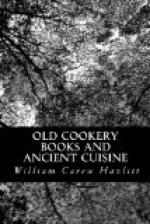Besides a general notion of the appointments of the cooking department, we are enabled to form some conception of the aspect of the early kitchen itself from extant representations in the “Archaeological Album,” the “Penny Magazine” for 1836, and Lacroix [Footnote: “Moeurs, Usages et Costumes au Moyen Age,” 1872, pp 166, 170, 177]. The last-named authority furnishes us with two interesting sixteenth century interiors from Jost Amman, and (from the same source) a portraiture of the cook of that period.
The costume of the subject is not only exhibited, doubtless with the fidelity characteristic of the artist, but is quite equally applicable to France, if not to our own country, and likewise to a much earlier date. The evidences of the same class supplied by the “Archaeological Album,” 1845, are drawn from the MS. in the British Museum, formerly belonging to the Abbey of St. Albans. They consist of two illustrations—one of Master Robert, cook to the abbey, as elsewhere noticed, accompanied by his wife—unique relic of its kind; the other a view of a small apartment with dressers and shelves, and with plates and accessories hung round, in which a cook, perhaps the identical Master Robert aforesaid, is plucking a bird. The fireplace is in the background, and the iron vessel which is to receive the fowl, or whatever it may really be, is suspended over the flame by a long chain. The perspective is rather faulty, and the details are not very copious; but for so early a period as the thirteenth or early part of the following century its value is undeniable.
The “Penny Magazine” presents us with a remarkable exterior, that of the venerable kitchen of Stanton-Harcourt, near Oxford, twenty-nine feet square and sixty feet in height. There are two large fireplaces, facing each other, but no chimney, the smoke issuing atthe holes, each about seven inches in diameter, which run round the roof. As Lamb said of his Essays, that they were all Preface, so this kitchen is all chimney. It is stated that the kitchen at Glastonbury Abbey was constructed on the same model; and both are probably older than the reign of Henry IV. The one to which I am more immediately referring, though, at the time (1835) the drawing was taken, in an excellent state of preservation, had evidently undergone repairs and structural changes.
It was at Stanton-Harcourt that Pope wrote a portion of his translation of Homer, about 1718.
A manufactory of brass cooking utensils was established at Wandsworth in or before Aubrey’s time by Dutchmen, who kept the art secret. Lysons states that the place where the industry was carried on bore the name of the “Frying Pan Houses” [Footnote: A “Environs of London,” 1st ed., Surrey, pp. 502-3].
In the North of England, the bake-stone, originally of the material to which it owed its name, but at a very early date constructed of iron, with the old appellations retained as usual, was the universal machinery for baking, and was placed on the Branderi, an iron frame which was fixed on the top of the fireplace, and consisted of iron bars, with a sliding or slott bar, to shift according to the circumstances.




